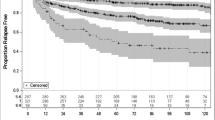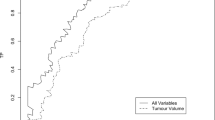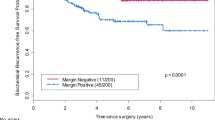Abstract
Objectives
Pathologic staging tries to maintain symmetry with clinical staging, allowing a direct comparison of both. However, in contrast to clinical substaging of T2 prostate cancers, is controversial whether pathologic T2 substaging conveys prognostic information. The aim of our study is to analyze the clinicopathologic findings and the prognostic information comparing the clinical with the pathological T2 substaging of patients submitted to radical prostatectomy.
Materials and methods
Using the 2009 TNM staging system, 169 patients with clinical stage T2a were compared with patients with stage T2b/T2c, and 142 patients with pathological stage T2a were compared with patients with stage T2c. All surgical specimens were step-sectioned. Using a semiquantitative point-count method for tumor extent evaluation, all insignificant tumors were excluded from analysis. Clinicopathological characteristics were compared between the groups. Biochemical recurrence data were compared using log-rank analysis, and significant predictors of time to biochemical recurrence were determined using univariate and multivariate Cox proportional hazards model.
Results
There was significant difference in biochemical recurrence rates between men with clinical T2a versus T2b/T2c tumors but no difference between men with pathological T2a versus T2c tumors. No patient in pathologic stage T2b was found. On multivariate analysis, clinical stage T2b/T2c was independent predictor of time to biochemical recurrence following surgery but not pathological stage T2c.
Conclusions
There is lack of symmetry between clinical and pathological T2 substaging as predictors of time to biochemical recurrence following surgery. The findings support a reevaluation of the TNM pathologic T2 stage, which should not be substratified.


Similar content being viewed by others
References
International Union Against Cancer (2009) TNM Classification of malignant tumours, 7th ed, Sobin LH, Gospodarowicz M, Wittekind Ch (eds). Geneva: Wiley-Blackwell, pp. 243–248
May F, Hartung R, Breul J (2001) The ability of the American Joint Committee on Cancer Staging system to predict progression-free survival after radical prostatectomy. BJU Int 88:702–707
Freedland SJ, Partin AW, Epstein JI et al (2004) Biochemical failure after radical prostatectomy in men with pathologic organ-confined disease: pT2a versus pT2b. Cancer 100:1646–1649
Chun FK, Briganti A, Lebeau T et al (2006) The 2002 AJCC pT2 substages confer no prognostic information on the rate of biochemical recurrence after radical prostatectomy. Eur Urol 49:273–278
van Oort IM, Witjes JA, Kok DE et al (2008) The prognostic role of the pathological T2 subclassification for prostate cancer in the 2002 Tumour-Nodes-Metastasis staging system. BJU Int 102:438–441
Hong SK, Han BK, Chung JS et al (2008) Evaluation of pT2 subdivisions in the TNM staging system for prostate cancer. BJU Int 102:1092–1096
Van der Kwast TH, Amin MB, Billis A et al. and the ISUP Prostate Cancer Group (2010) International Society of Urological Pathology (ISUP) consensus conference on handling and staging of radical prostatectomy specimens. Working group 2: T2 substaging and prostate cancer volume. Mod Pathol [Epub ahead of print]
Cookson MS, Aus G, Burnett AL, Canby-Hagino ED et al (2007) Variation in the definition of biochemical recurrence in patients treated for localized prostate cancer: the American Urological Association Prostate Guidelines for Localized Prostate cancer Update Panel report and recommendations for a standard in the reporting of surgical outcomes. J Urol 177:540–545
Epstein JI, Allsbrook WC Jr, Amin MB, The ISUP grading committee et al (2005) The 2005 international society of urological pathology (ISUP) consensus conference on gleason grading of prostatic carcinoma. Am J Surg Pathol 29:1228–1242
Billis A, Magna LA, Ferreira U (2003) Correlation between tumor extent in radical prostatectomies and preoperative PSA, histological grade, surgical margins, and extraprostatic extension: application of a new practical method for tumor extent evaluation. Int Braz J Urol 29:113–119
Billis A, Freitas LLL, Magna LA et al (2004) Prostate cancer with bladder neck involvement: pathologic findings with application of a new practical method for tumor extent evaluation and recurrence-free survival after radical prostatectomy. Int Urol Nephrol 36:363–368
Van der Kwast TH (2006) Substaging pathologically organ confined (pT2) prostate cancer: an exercise in futility? Eur Urol 49:209–211
International Union Against Cancer (1997). TNM Classification of malignant tumours, 5th ed, Sobin LH, Wittekind Ch (eds). New York:Wiley-Liss, pp. 170-173
International Union Against Cancer (2002) TNM Classification of malignant tumours, 6th ed, Sobin LH, Wittekind Ch (eds). New York:Wiley-Liss, pp. 184-187
Armatys SA, Koch MO, Bihrle R (2005) Is it necessary to separate clinical stage T1c from T2 prostate adenocarcinoma? BJU Int 96:777–780
Freedland SJ, Presti JC Jr, Terris MK et al (2003) The SEARCH Database Study Group. Improved clinical staging system combining biopsy laterality and TNM stage for men with T1c and T2 prostate cancer: results from the SEARCH database. J Urol 169:2129–2135
Cagiannos I, Graefen M, Karakiewicz PI et al (2002) Analysis of clinical stage T2 prostate cancer: do current subclassifications represent an improvement? J Clin Oncol 20:2025–2035
Han M, Walsh PC, Partin AW et al (2000) Ability of the 1992 and 1997 American Joint Committee on Cancer staging systems for prostate cancer to predict progression-free survival after radical prostatectomy for stage T2 disease. J Urol 164:89–92
Smith DS, Catalona WJ (1995) Interexaminer variability of digital rectal examination in detecting prostate cancer. Urology 45:70–74
Obek C, Louis P, Civantos F et al (1999) Comparison of digital rectal examination and biopsy results with the radical prostatectomy specimen. J Urol 161:494–498
Eichelberger LE, Cheng L (2004) Does pT2b cancer exist? Critical appraisal of the 2002 TNM classification of prostate cancer. Cancer 100:2573–2576
Quintal MM, Magna LA, Guimaraes MS et al (2006) Prostate cancer pathologic stage pT2b (2002 TNM staging system): does it exist? Int Braz J Urol 32:43–47
Arora R, Koch MO, Eble JN et al (2004) Heterogeneity of Gleason grade in multifocal adenocarcinoma of the prostate. Cancer 100:2362–2366
Wise AM, Stamey TA, McNeal JE et al (2002) Morphologic and clinical significance of multifocal prostate cancers in radical prostatectomy specimens. Urology 60:264–269
Author information
Authors and Affiliations
Corresponding author
Rights and permissions
About this article
Cite this article
Billis, A., Meirelles, L.L., Freitas, L.L.L. et al. Should pathologists continue to use the current pT2 substaging system for reporting of radical prostatectomy specimens?. Int Urol Nephrol 43, 707–714 (2011). https://doi.org/10.1007/s11255-011-9906-0
Received:
Accepted:
Published:
Issue Date:
DOI: https://doi.org/10.1007/s11255-011-9906-0




